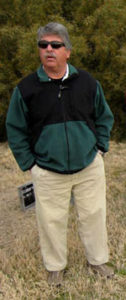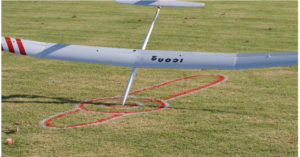Hacker Para-RC Meet, Augsburg, Aug. 22, 23, 24 2015
September 2, 2015Estingoy Soaring Column

Don Peters, 2010.
June, 2010
Hi group, my name is Lee and I’m a Soaring addict. Today we have a special treat. Master airframer Don Peters, the man behind Maple Leaf design, has been kind enough to share some of his thoughts and experiences with us.
Don’s planes, most notably the Icon, have led the trend towards larger ships for competition sailplanes. His latest ship, the Icon 2, represents the very best in US model sailplane design and building artistry. I’ll let Don take it from here!
Lee: How long have you been making models commercially? Is this your day job?
Don: I built my first commercial sailplane about fifteen years ago. After about two years I had a significant backorder – enough to quit my “real” job and build airplanes full-time.
Lee: How have the building processes changed since then? Has it been hard to adapt?
Don: In those early days “bagged” wings were cutting edge. The technology was pretty simple, and the designs adapted well. You needed some light E glass, a tiny 1/6 hp vacuum pump and some 14 mil Mylar, and you were a state-of-the-art builder.
I began building hollow molded wings for the two meter Image after doing about fifty of them with bagged wings.
I remember being really surprised that molded wings are actually heavier than bagged wings. Molded wings weren’t that hard to adapt to, but they do require a lot more tooling and equipment. And, while you can take molds from hand-built masters, it makes a lot more sense to use computer controlled machines.
Lee: I would imagine that new plane development is evolutionary, but the Icon and Icon 2 seem to be dramatically different from the models made by the European manufacturers. Are your ships designed to play the same game? Why the differences?
Don: The original Icon was certainly bigger that the Euro planes at the time. In those days – about twelve years ago – it was thought that larger planes wouldn’t launch. The Icon was designed by Joe Wurtz, who was convinced that that was nonsense, and he was right. The Icon 2 follows that trend, again mostly at the suggestion of the designer, Mark Drela. Bigger planes have a number of inherent advantages: they are more efficient – they have less drag, they cover more ground, and they’re easier to see.
They launch just as well, although they are harder on tow lines, and they can land just as well.
Lee: How do you go about prototyping a plane? Don’t molded planes require a substantial investment in plugs and molds? How can you make changes to the design?
Don: I remember asking Joe Wurtz if he thought it made sense to test the Icon design by building a six or eight panel bagged wing. He replied that the increased drag losses built into such a prototype would negate its testing value. And the model market is way too small to do the kind of initial research and development that companies like Boeing or Lockheed could afford.
So, as a model builder, you have to take several significant up-front risks. The tooling is so expensive, and my company is so small that I have to commit to the best design thinking I can find and then work with it to get the desired result.
We were unbelievably lucky with the Icon. It probably could have benefitted from a larger horizontal stabilizer, but nobody felt strongly enough to actually do anything about it. T
The I2 has been a very different experience. While the wing was just about perfect – we haven’t made any changes to it – the fuse and empennage have required quite a bit of development work to get it to the level required for international competition. This is expensive because the engineering is almost totally iterative – you develop the idea, then you build the necessary tooling, then you test the plane with the new part. From that you learn what you should have done, then you start the process again. You often destroy some part or all of a plane in each iteration, then throw away the new tooling too just to add insult to injury.
The I2 has required two years and two fuse molds, two rudder molds, four stab molds and three nose cone molds — all with numerous builds.
The project has benefitted from lots of time and valued input from probably fifty committed clients including four world champions. But I’m still using the original wing mold – thank you Mark Drela.
Lee: What sort of aerodynamic design work is done on your models?
Don: Here, again, we all need to thank Mark Drela. Mark is a professor of aerodynamics at MIT. He is also quite a good sailplane pilot and one of the best model builders I know. Years ago he developed a computer program called X-foil to predict the performance of air foils. He released it to the public domain so everyone with the smarts to understand it could use it essentially free. Joe used it running on the big computers at Lockheed’s Skunk Works to design the original Icon airfoils. Mark used it to design the AG series of airfoils which are used in the I2. He was also responsible for the I2 planform, i.e., he did the whole wing.
Lee: There are a lot of us duffers out there who somehow manage to get a world class plane in our hands. From your unique perspective what is the best thing a club-level pilot can do to improve his skills and performance. How much is the plane and how much is the pilot?
Don: I’m a great believer in buying the best equipment you can afford, then flying the bejesus out of it until you really learn it. In fact, that’s what guys like Cody and Daryl do. And they practice a LOT more, and they’re WAY better pilots than the rest of us, so they really learn a plane. Certainly its the pilot.
But its also worth noting that the hot pilots can all pretty much fly what they want, so they’re flying planes that perform well and are suited to their flying style.
Lee: What is your favorite plane to go fly for fun these days?
Don: I’m a dyed in the wool hand launch junkie. I still have the most fun chasing small thermals with my beat-up six year old Encore.
Lee: What is your Rosebud, or plane that left the biggest mark on you?
Don: I guess it’s got to be the I2 because of the increased performance and structural issues involved in such a big plane. I’ve learned more from the project than any other I’ve been involved with. As originally delivered, it was a decent plane, but it wasn’t all that easy to fly well. I’m not a very good pilot, but I’m pretty observant, and I could see flashes of brilliance, but there was some stuff that needed to be sorted out.
The tail boom was flexing too much on launch, so we retooled the fuse. Skip Miller got involved early on, he identified the need for a much bigger horizontal stabilizer…. like sixty percent bigger.
Well, those Great Big Stabs had flutter issues. By the time we sorted that out, the fins developed flutter issues. We initially solved the flutter problems by just simply building heavier parts – hardly an elegant solution.
By this time Daryl Perkins was flying the plane, and he brought a four-time World Champion’s perspective to the project. So we spent months fine tuning the build. Ultimately we developed a stronger, stiffer 3.8 meter airframe that weighs about the same as a 3.3 meter airframe.
Lee: How many man hours are required to build a modern molded plane once in production?
Don: It takes about ten working days to build an I2. Compare that to about 6 working days to build the original Icon.
Lee: Any words of wisdom you’d like to pass on to the Soaring community?
Don: I don’t know that I have much wisdom. I always reflect on Mark Twain’s observation that, “Good judgment comes mostly from experience, and experience mostly comes from bad judgment.”

